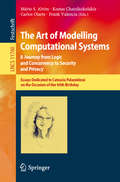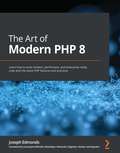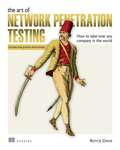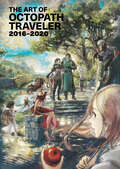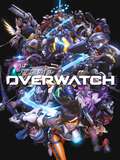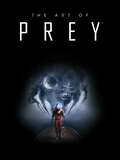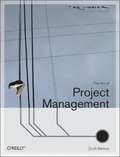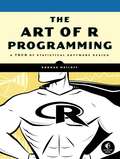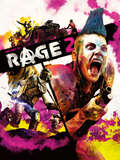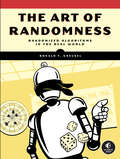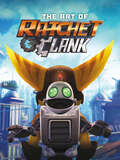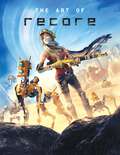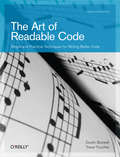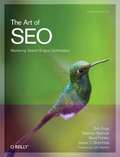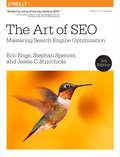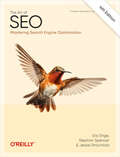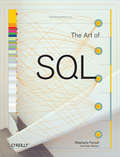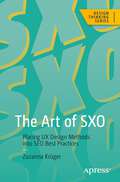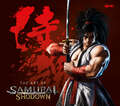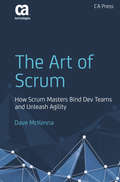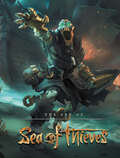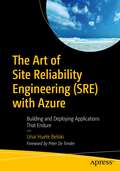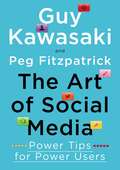- Table View
- List View
The Art of Modelling Computational Systems: Essays Dedicated to Catuscia Palamidessi on the Occasion of Her 60th Birthday (Lecture Notes in Computer Science #11760)
by Mário S. Alvim Kostas Chatzikokolakis Carlos Olarte Frank ValenciaThis Festschrift was published in honor of Catuscia Palamidessi on the occasion of her 60th birthday.It features 6 laudations, which are available in the front matter of the volume, and 25 papers by close collaborators and friends. The papers are organized in topical sections named: concurrency; logic and constraint programming; security and privacy; and models and puzzles.These contributions are a tribute to Catuscia Palamidessi’s intellectual depth, vision, passion for science, and tenacity in solving technical problems. They also reflect the breadth and impact of her work. Her scientific interests include, in chronological order, principles of programming languages, concurrency theory, security, and privacy.
The Art of Modern PHP 8: Learn how to write modern, performant, and enterprise-ready code with the latest PHP features and practices
by Lorna Jane Mitchell Joseph EdmondsDiscover how to apply the principles of OOP, types, and package management the right wayKey FeaturesExplore the latest PHP 8.1 features and modern web development practicesRefactor your legacy codebase using modern features and styles in PHPCreate your own Composer packages that can be reused across all PHP projectsBook DescriptionPHP has come a long way since its introduction. While the language has evolved with PHP 8, there are still a lot of websites running on a version of PHP that is no longer supported. If you are a PHP developer working with legacy PHP systems and want to discover the tenants of modern PHP, this is the book for you. The Art of Modern PHP 8 walks you through the latest PHP features and language concepts. The book helps you upgrade your knowledge of PHP programming and practices. Starting with object-oriented programming (OOP) in PHP and related language features, you'll work through modern programming techniques such as inheritance, understand how it contrasts with composition, and finally look at more advanced language features. You'll learn about the MVC pattern by developing your own MVC system and advance to understanding what a DI container does by building a toy DI container. The book gives you an overview of Composer and how to use it to create reusable PHP packages. You'll also find techniques for deploying these packages to package libraries for other developers to explore. By the end of this PHP book, you'll have equipped yourself with modern server-side programming techniques using the latest versions of PHP.What you will learnUnderstand how to use modern PHP features such as objects, types, and moreGet to grips with PHP package management using ComposerExplore dependency injection for your PHP applicationsFind out what the differences are between legacy and modern PHP 8 code and practicesWrite clean PHP code and implement design patternsGet hands-on with modern PHP using examples applying MVC and DI techniquesWho this book is forThe book is for existing PHP developers and CTO-level professionals who are working with PHP technologies, including legacy PHP, in production. The book assumes beginner-level knowledge of PHP programming as well as experience with server-side development.
The Art of Network Penetration Testing: How to take over any company in the world
by Royce DavisThe Art of Network Penetration Testing is a guide to simulating an internal security breach. You&’ll take on the role of the attacker and work through every stage of a professional pentest, from information gathering to seizing control of a system and owning the network.Summary Penetration testing is about more than just getting through a perimeter firewall. The biggest security threats are inside the network, where attackers can rampage through sensitive data by exploiting weak access controls and poorly patched software. Designed for up-and-coming security professionals, The Art of Network Penetration Testing teaches you how to take over an enterprise network from the inside. It lays out every stage of an internal security assessment step-by-step, showing you how to identify weaknesses before a malicious invader can do real damage. Purchase of the print book includes a free eBook in PDF, Kindle, and ePub formats from Manning Publications. About the technology Penetration testers uncover security gaps by attacking networks exactly like malicious intruders do. To become a world-class pentester, you need to master offensive security concepts, leverage a proven methodology, and practice, practice, practice. Th is book delivers insights from security expert Royce Davis, along with a virtual testing environment you can use to hone your skills. About the book The Art of Network Penetration Testing is a guide to simulating an internal security breach. You&’ll take on the role of the attacker and work through every stage of a professional pentest, from information gathering to seizing control of a system and owning the network. As you brute force passwords, exploit unpatched services, and elevate network level privileges, you&’ll learn where the weaknesses are—and how to take advantage of them. What's inside Set up a virtual pentest lab Exploit Windows and Linux network vulnerabilities Establish persistent re-entry to compromised targets Detail your findings in an engagement report About the reader For tech professionals. No security experience required. About the author Royce Davis has orchestrated hundreds of penetration tests, helping to secure many of the largest companies in the world. Table of Contents 1 Network Penetration Testing PHASE 1 - INFORMATION GATHERING 2 Discovering network hosts 3 Discovering network services 4 Discovering network vulnerabilities PHASE 2 - FOCUSED PENETRATION 5 Attacking vulnerable web services 6 Attacking vulnerable database services 7 Attacking unpatched services PHASE 3 - POST-EXPLOITATION AND PRIVILEGE ESCALATION 8 Windows post-exploitation 9 Linux or UNIX post-exploitation 10 Controlling the entire network PHASE 4 - DOCUMENTATION 11 Post-engagement cleanup 12 Writing a solid pentest deliverable
The Art of Octopath Traveler: 2016-2020
by Square EnixJourney across the fantastic world of Octopath Traveler with over 200 pages of concept art and developer commentary collected in a stunning hardcover volume!Join the travelers in their journey through Orsterra and discover each of their unique origins. Delve into a fantasy landscape full of amazing creatures and scenery. Ponder the inspired design and artistic passion—all through incredible art from the creation of the critically acclaimed Octopath Traveler and Octopath Traveler: Champions of the Continent.Dark Horse Books and Square Enix present The Art of Octopath Traveler, officially published in English for the first time! This localization of original Japanese material features gorgeous concept art and extensive commentary from the games&’ creative teams. Discover what lies beyond the horizon!
The Art of Overwatch
by BlizzardOverwatch has taken the world by storm, boasting millions of players and gaining critical acclaim. Now, in this beautiful hardcover, Blizzard Entertainment reveals the creative process behind one of the most popular FPS games of all time! Filled with never-before-seen art as well as commentary provided by the game&’s development team, this book is sure to please any Overwatch fan. · Essential companion to the international best-selling game Overwatch! · Introduction and commentary provided by the game&’s development team! · Overwatch is a global phenomenon with 30 million players! · Produced in close partnership with Blizzard Entertainment! · Overwatch creation revealed! · Behind-the-scenes look at your favorite characters! · Never-before-seen artwork!
The Art of Prey
by BethesdaA dark force torments the enigmatic space station Talos I, and the key to survival depends not just on strength or weaponry, but on wits as well. Journey alongside Morgan Yu to explore the depths of Prey, a new science-fiction action game from the makers of Dishonored.Arkane Studios and Dark Horse Books are proud to present The Art of Prey. This exquisite and comprehensive collection features hundreds of pieces of gorgeous art from the development of this hotly anticipated game, showcasing Arkane's signature world-building and attention to detail with a unique take on futuristic design.The comprehensive art guide to the mysterious Prey universe! Exclusive never before seen concept art from the development of the highly anticipated Prey! One of PCAdvisor and GamesRadar's most anticipated games of 2017!
The Art of Project Management
by Scott Berkun"'The Art of Project Management' covers it all--from practical methods for making sure work gets done right and on time, to the mindset that can make you a great leader motivating your team to do their best. Reading this was like reading the blueprint for how the best projects are managed at Microsoft... I wish we always put these lessons into action!" --Joe Belfiore, General Manager, E-home Division, Microsoft Corporation "Berkun has written a fast paced, jargon-free and witty guide to what he wisely refers to as the 'art' of project management. It's a great introduction to the discipline. Seasoned and new managers will benefit from Berkun's perspectives." --Joe Mirza, Director, CNET Networks (Cnet.com) "Most books with the words 'project management' in the title are dry tomes. If that's what you are expecting to hear from Berkun's book, you will be pleasantly surprised. Sure, it's about project management. But it's also about creativity, situational problem-solving, and leadership. If you're a team member, project manager, or even a non-technical stakeholder, Scott offers dozens of practical tools and techniques you can use, and questions you can ask, to ensure your projects succeed." --Bill Bliss, Senior VP of product and customer experience, expedia.com In The Art of Project Management , you'll learn from a veteran manager of software and web development how to plan, manage and lead projects. This personal account of hard lessons learned over a decade of work in the industry distills complex concepts and challenges into practical nuggets of useful advice. Inspiring, funny, honest, and compelling, this is the book you and your team need to have within arms reach. It will serve you well with your current work, and on future projects to come. Topics include: How to make things happen Making good decisions Specifications and requirements Ideas and what to do with them How not to annoy people Leadership and trust The truth about making dates What to do when things go wrong
The Art of R Programming: A Tour of Statistical Software Design
by Norman MatloffR is the world's most popular language for developing statistical software: Archaeologists use it to track the spread of ancient civilizations, drug companies use it to discover which medications are safe and effective, and actuaries use it to assess financial risks and keep economies running smoothly.The Art of R Programming takes you on a guided tour of software development with R, from basic types and data structures to advanced topics like closures, recursion, and anonymous functions. No statistical knowledge is required, and your programming skills can range from hobbyist to pro.Along the way, you'll learn about functional and object-oriented programming, running mathematical simulations, and rearranging complex data into simpler, more useful formats. You'll also learn to:–Create artful graphs to visualize complex data sets and functions–Write more efficient code using parallel R and vectorization–Interface R with C/C++ and Python for increased speed or functionality–Find new R packages for text analysis, image manipulation, and more–Squash annoying bugs with advanced debugging techniquesWhether you're designing aircraft, forecasting the weather, or you just need to tame your data, The Art of R Programming is your guide to harnessing the power of statistical computing.
The Art of RAGE 2
by Avalanche StudiosAn outrageous collection of art and commentary from the development of id Software and Avalanche Studios' dystopian first-person-shooter, RAGE 2!Delving into the rebellious world of the Wasteland, this volume examines the most intense moments of RAGE 2 in an extensive fusion of art and commentary! Explore the split scenery of lush overgrowth and desolate deserts in concepts and renders from across the incredible setting. This wicked collection details the game's wide-open world, insane characters, and big f%$@ing guns--all with exclusive commentary from the game's developers.Dark Horse Books joins with Bethesda Softworks and id Software, the creators of the first-person shooter genre, to present The Art of RAGE 2. Don't miss out on this vital addition to any wild wastelander's collection.
The Art of Randomness: Randomized Algorithms in the Real World
by Ronald T. KneuselHarness the power of randomness (and Python code) to solve real-world problems in fun, hands-on experiments—from simulating evolution to encrypting messages to making machine-learning algorithms!The Art of Randomness is a hands-on guide to mastering the many ways you can use randomized algorithms to solve real programming and scientific problems. You&’ll learn how to use randomness to run simulations, hide information, design experiments, and even create art and music. All you need is some Python, basic high school math, and a roll of the dice.Author Ronald T. Kneusel focuses on helping you build your intuition so that you&’ll know when and how to use random processes to get things done. You&’ll develop a randomness engine (a Python class that supplies random values from your chosen source), then explore how to leverage randomness to:Simulate Darwinian evolution and optimize with swarm-based search algorithmsDesign scientific experiments to produce more meaningful results by making them truly randomImplement machine learning algorithms like neural networks and random forestsUse Markov Chain Monte Carlo methods to sample from complex distributionsHide information in audio files and images, generate art, and create musicReconstruct original signals and images from only randomly sampled dataScientific anecdotes and code examples throughout illustrate how randomness plays into areas like optimization, machine learning, and audio signals. End-of-chapter exercises encourage further exploration.Whether you&’re a programmer, scientist, engineer, mathematician, or artist, you&’ll find The Art of Randomness to be your ticket to discovering the hidden power of applied randomness and the ways it can transform your approach to solving problems, from the technical to the artistic.
The Art of Ratchet & Clank
by Sony Computer EntertainmentA retrospective exploration of the galaxy's most lovable video game heroes--Ratchet and Clank!For fifteen years the most unlikely heroes in the cosmos have been adventuring across the stars, kicking butt and taking names. Ratchet and Clank have rescued innocent civilizations, taken down evil corporations, defeated robot armies, incited space prison breakouts, and even colluded with interstellar pirates! Now, Dark Horse Books and Insomniac Games proudly offer a look back at the history of the iconic series in a Qwark-tastic collection of never-before-seen concept art and behind-the-scenes commentary chronicling eleven amazing games and the brilliant studio that created them!
The Art of ReCore
by ART TKFrom the legendary makers of Metroid Prime comes ReCore, an action-adventure game that pits the player against devious robotic foes while forging friendships with a courageous group of uniquely powerful robot companions!Now, Dark Horse Books presents this comprehensive volume, examining the art and inspiration behind this mysterious and dynamic world with The Art of ReCore!* Featuring commentary from the game&’s creators!* The essential companion to the highly anticipated game!* Collecting hundreds of pieces of never-before-seen art!
The Art of Readable Code: Simple and Practical Techniques for Writing Better Code (O'reilly Ser.)
by Dustin Boswell Trevor FoucherAs programmers, we’ve all seen source code that’s so ugly and buggy it makes our brain ache. Over the past five years, authors Dustin Boswell and Trevor Foucher have analyzed hundreds of examples of "bad code" (much of it their own) to determine why they’re bad and how they could be improved. Their conclusion? You need to write code that minimizes the time it would take someone else to understand it—even if that someone else is you.This book focuses on basic principles and practical techniques you can apply every time you write code. Using easy-to-digest code examples from different languages, each chapter dives into a different aspect of coding, and demonstrates how you can make your code easy to understand.Simplify naming, commenting, and formatting with tips that apply to every line of codeRefine your program’s loops, logic, and variables to reduce complexity and confusionAttack problems at the function level, such as reorganizing blocks of code to do one task at a timeWrite effective test code that is thorough and concise—as well as readable"Being aware of how the code you create affects those who look at it later is an important part of developing software. The authors did a great job in taking you through the different aspects of this challenge, explaining the details with instructive examples."—Michael Hunger, passionate Software Developer
The Art of Reinforcement Learning: Fundamentals, Mathematics, and Implementations with Python
by Michael HuUnlock the full potential of reinforcement learning (RL), a crucial subfield of Artificial Intelligence, with this comprehensive guide. This book provides a deep dive into RL's core concepts, mathematics, and practical algorithms, helping you to develop a thorough understanding of this cutting-edge technology. Beginning with an overview of fundamental concepts such as Markov decision processes, dynamic programming, Monte Carlo methods, and temporal difference learning, this book uses clear and concise examples to explain the basics of RL theory. The following section covers value function approximation, a critical technique in RL, and explores various policy approximations such as policy gradient methods and advanced algorithms like Proximal Policy Optimization (PPO). This book also delves into advanced topics, including distributed reinforcement learning, curiosity-driven exploration, and the famous AlphaZero algorithm, providing readers with a detailed account of these cutting-edge techniques. With a focus on explaining algorithms and the intuition behind them, The Art of Reinforcement Learning includes practical source code examples that you can use to implement RL algorithms. Upon completing this book, you will have a deep understanding of the concepts, mathematics, and algorithms behind reinforcement learning, making it an essential resource for AI practitioners, researchers, and students. What You Will Learn Grasp fundamental concepts and distinguishing features of reinforcement learning, including how it differs from other AI and non-interactive machine learning approachesModel problems as Markov decision processes, and how to evaluate and optimize policies using dynamic programming, Monte Carlo methods, and temporal difference learningUtilize techniques for approximating value functions and policies, including linear and nonlinear value function approximation and policy gradient methodsUnderstand the architecture and advantages of distributed reinforcement learningMaster the concept of curiosity-driven exploration and how it can be leveraged to improve reinforcement learning agentsExplore the AlphaZero algorithm and how it was able to beat professional Go players Who This Book Is For Machine learning engineers, data scientists, software engineers, and developers who want to incorporate reinforcement learning algorithms into their projects and applications.
The Art of SEO
by Eric Enge Stephan Spencer Rand Fishkin Jessie C. StricchiolaA well-designed, easy-to-navigate website is useless if no one can find it. If your company is going to succeed in the web economy, optimizing your site for search engine visibility is essential. In this book, four of the most noted experts in the field of search engine optimization (SEO) provide you with proven guidelines and cutting-edge techniques for planning and executing a comprehensive SEO strategy. The authors clearly explain SEO fundamentals, while correcting many common misconceptions. If you are new to SEO, you'll get a complete and thorough SEO education, as well as an array of effective tactics, from basic to advanced. Seasoned practitioners will find this book useful as a complete reference to SEO best practices. Explore the underlying theory behind SEO and how search engines work Learn the steps you need to prepare for, execute, and evaluate SEO initiatives Examine a number of advanced strategies and tactics Understand the intricacies involved in managing complex SEO projects Learn what's necessary to build a competent SEO team with defined roles Glimpse the future of search and what lies ahead for the SEO industry
The Art of SEO: Mastering Search Engine Optimization
by Eric Enge Stephan Spencer Jessie StricchiolaThree acknowledged experts in search engine optimization share guidelines and innovative techniques that will help you plan and execute a comprehensive SEO strategy. Complete with an array of effective tactics from basic to advanced, this third edition includes updates on SEO tools, and new search engine ranking methods that have reshaped the SEO landscape.Novices will receive a thorough SEO education, while experienced SEO practitioners get an extensive reference to support ongoing engagements.Comprehend SEO's many intricacies and complexitiesExplore the underlying theory and inner workings of search enginesUnderstand the role of social media, user data, and linksDiscover tools to track results and measure successExamine the effects of Google's Panda and Penguin algorithmsConsider opportunities in mobile, local, and vertical SEOBuild a competent SEO team with defined rolesGlimpse the future of search and the SEO industryVisit the book website (http://www.artofseobook.com) for FAQs and to post your own burning questions. You'll have access to special offers and discounts on various SEO tools and services. You can also get exclusive access to instructional videos related to the concepts in the book by sending an email to bonuses@artofseobook.com.
The Art of SEO: Mastering Search Engine Optimization
by Eric Enge Stephan Spencer Jessie StricchiolaThree acknowledged experts in search engine optimization share guidelines and innovative techniques that will help you plan and execute a comprehensive SEO strategy. Complete with an array of effective tactics from basic to advanced, this fourth edition prepares digital marketers for 2023 and beyond with updates on SEO tools and new search engine optimization methods that have reshaped the SEO landscape, including how generative AI can be used to support SEO and SEO-related tasks.Novices will receive a thorough SEO education, while experienced SEO practitioners get an extensive reference to support ongoing engagements.Learn about the various intricacies and complexities of internet searchExplore the underlying theory and inner workings of search engines and their algorithmsUnderstand the interplay between social media engagement and other factorsDiscover tools to track results and measure successExamine the effects of key Google algorithm updatesConsider opportunities for visibility in mobile, local, vertical, social, and voice searchBuild a competent SEO team with defined rolesIdentify what opportunities exist for using generative AI as part of an SEO programGain insights into the future of search and internet discoverability
The Art of SQL
by Stephane Faroult Peter RobsonFor all the buzz about trendy IT techniques, data processing is still at the core of our systems, especially now that enterprises all over the world are confronted with exploding volumes of data. Database performance has become a major headache, and most IT departments believe that developers should provide simple SQL code to solve immediate problems and let DBAs tune any "bad SQL" later. In The Art of SQL, author and SQL expert Stephane Faroult argues that this "safe approach" only leads to disaster. His insightful book, named after Art of War by Sun Tzu, contends that writing quick inefficient code is sweeping the dirt under the rug. SQL code may run for 5 to 10 years, surviving several major releases of the database management system and on several generations of hardware. The code must be fast and sound from the start, and that requires a firm understanding of SQL and relational theory. The Art of SQL offers best practices that teach experienced SQL users to focus on strategy rather than specifics. Faroult's approach takes a page from Sun Tzu's classic treatise by viewing database design as a military campaign. You need knowledge, skills, and talent. Talent can't be taught, but every strategist from Sun Tzu to modern-day generals believed that it can be nurtured through the experience of others. They passed on their experience acquired in the field through basic principles that served as guiding stars amid the sound and fury of battle. This is what Faroult does with SQL. Like a successful battle plan, good architectural choices are based on contingencies. What if the volume of this or that table increases unexpectedly? What if, following a merger, the number of users doubles? What if you want to keep several years of data online? Faroult's way of looking at SQL performance may be unconventional and unique, but he's deadly serious about writing good SQL and using SQL well. The Art of SQL is not a cookbook, listing problems and giving recipes. The aim is to get you-and your manager-to raise good questions.
The Art of SQL
by Stephane Faroult Peter RobsonFor all the buzz about trendy IT techniques, data processing is still at the core of our systems, especially now that enterprises all over the world are confronted with exploding volumes of data. Database performance has become a major headache, and most IT departments believe that developers should provide simple SQL code to solve immediate problems and let DBAs tune any "bad SQL" later.In The Art of SQL, author and SQL expert Stephane Faroult argues that this "safe approach" only leads to disaster. His insightful book, named after Art of War by Sun Tzu, contends that writing quick inefficient code is sweeping the dirt under the rug. SQL code may run for 5 to 10 years, surviving several major releases of the database management system and on several generations of hardware. The code must be fast and sound from the start, and that requires a firm understanding of SQL and relational theory.The Art of SQL offers best practices that teach experienced SQL users to focus on strategy rather than specifics. Faroult's approach takes a page from Sun Tzu's classic treatise by viewing database design as a military campaign. You need knowledge, skills, and talent. Talent can't be taught, but every strategist from Sun Tzu to modern-day generals believed that it can be nurtured through the experience of others. They passed on their experience acquired in the field through basic principles that served as guiding stars amid the sound and fury of battle. This is what Faroult does with SQL.Like a successful battle plan, good architectural choices are based on contingencies. What if the volume of this or that table increases unexpectedly? What if, following a merger, the number of users doubles? What if you want to keep several years of data online? Faroult's way of looking at SQL performance may be unconventional and unique, but he's deadly serious about writing good SQL and using SQL well. The Art of SQL is not a cookbook, listing problems and giving recipes. The aim is to get you-and your manager-to raise good questions.
The Art of SXO: Placing UX Design Methods into SEO Best Practices (Design Thinking)
by Zuzanna KrügerSearch Experience Optimization (SXO) is a fast growing field that combines the disciplines of Search Engine Optimization (SEO), Conversion Rate Optimization (CRO) and User Experience (UX) Design. It’s a holistic approach to creating websites that are not only optimized for search engines and bots, but for users too, a highly effective method of converting a websites visitors into customers and subscribers, leading some to think of it as SEO 2.0. Recent industry reports suggests that front-end developers and web designers need to embrace SXO best practices to not only ensure websites are optimized by the metadata and analytics that SEO provides, but also ensure a website or application is easy-to-use and behaves in a way the user expects because happy users drive higher retention rates and higher revenue, which is essential for commercial app creators. The Art of SXO aims to be a comprehensive guide to this emerging field, explaining what it is, how it works, and how to use it to improve search rankings, increase conversions rates, and ultimately grow a company's revenue. This guide will be packed with tips, tricks, and tactics making it an essential resource for anyone looking to get the most out of their search traffic.What You'll LearnApply SXO best practices and how it differs from tradition SEOOptimize websites for both search engine bots and users Increase a website's ranking in SERPsImprove a website's conversion ratesGrow revenue from organic trafficWho This Book Is ForWeb developers and UX designers, technical SEO specialists, digital marketers and business owners who may have a basic understanding of SEO, CRO, UX design and core digital marketing concepts, but are looking to take their practices to the next level with SXO.
The Art of Samurai Shodown
by SNKA glorious digital tome collecting concept art and creator commentary from the development of the newest entry in the Samurai Shodown saga.Since 1993, SNK has rocked the fighting-game world with the visceral combat, iconic characters, and dynamic settings of Samurai Shodown! Now, The Art of Samurai Shodown offers unique insights into the making of the long-awaited revival of the classic fighting franchise. This volume contains nearly 700 documents and illustrations that were used to create the blockbuster game, showcasing this latest episode in thrilling hyper-detail!Dark Horse Books and SNK welcome you to explore this beautiful and dangerous world with this striking, in-depth look at the game that embodies the samurai spirit!
The Art of Scrum
by Dave MckennaLearn the nuts and bolts of scrum--its framework, roles, team structures, ceremonies, and artifacts--from the scrum master's perspective. The Art of Scrum details the scum master's responsibilities and core functions in planning and facilitating the ceremonies and artifacts of a scrum team: sprint planning, sprint execution, backlog refinement, daily standups, sprint reviews, and sprint retrospectives. It analyzes the scrum master's interactions with other scrum roles, including the product owner, development team members, other scrum masters, and the agile coach. Scrum Master Dave McKenna catalogs the three skill sets that you must master to be successful at binding teams and unleashing agility: soft skills, technical skills, and contingency skills. You'll benefit from the author's examination of these skill sets with insights and anecdotes drawn from his own experience as an engineer, agile coach, and scrum master. He illustrates common mistakes scrum masters make, as well as modeling successful strategies, adaptations to changes, and solutions to tricky problems. What You'll Learn: How scrum masters facilitate the agile ceremonies How scrum masters align scrum teams to sprint goals and shield them from interference How scrum masters coach product owners to build a backlog and refine user stories How scrum masters manage contingencies such as intra-team conflicts, organizational impediments, technical debt, emergent architecture, personnel changes, scope creep, and learning from failure. Who This Book Is For: The primary readership is scrum masters, product owners, and dev team members. The secondary readership is scrum stakeholders, including executive sponsors, project managers, functional and line managers, administrative personnel, expert consultants, testers, vendors, and end users. The tertiary readership is anybody who wants to know how build an agile team that consistently delivers value and continuous improvement.
The Art of Sea of Thieves
by Rare Microsoft StudiosA high-quality collectible art book featuring over 200 pages of behind-the-scenes content from the hotly anticipated, shared-world video game Sea of Thieves!With Rare's new high seas multiplayer adventure Sea of Thieves, players will crew up in search of fortune and glory on their quest to become pirate legends. Now, with The Art of Sea of Thieves, Dark Horse Books is pleased to offer an unprecedented look at the ships, characters, and loot of this revolutionary online gaming experience! Featuring hundreds of pieces of art with commentary from the game's creators, this gorgeous volume explores the creation and development of a fantastical pirate world.
The Art of Site Reliability Engineering (SRE) with Azure: Building and Deploying Applications That Endure
by Unai Huete BelokiGain a foundational understanding of SRE and learn its basic concepts and architectural best practices for deploying Azure IaaS, PaaS, and microservices-based resilient architectures. The book starts with the base concepts of SRE operations and developer needs, followed by definitions and acronyms of Service Level Agreements in real-world scenarios. Moving forward, you will learn how to build resilient IaaS solutions, PaaS solutions, and microservices architecture in Azure. Here you will go through Azure reference architecture for high-available storage, networking and virtual machine computing, describing Availability Sets and Zones and Scale Sets as main scenarios. You will explore similar reference architectures for Platform Services such as App Services with Web Apps, and work with data solutions like Azure SQL and Azure Cosmos DB. Next, you will learn automation to enable SRE with Azure DevOps Pipelines and GitHub Actions. You’ll also gain an understanding of how an open culture around post-mortems dramatically helps in optimizing SRE and the overall company culture around managing and running IT systems and application workloads. You’ll be exposed to incent management and monitoring practices, by making use of Azure Monitor/Log Analytics/Grafana, which forms the foundation of monitoring Azure and Hybrid-running workloads. As an extra, the book covers two new testing solutions: Azure Chaos Studio and Azure Load Testing. These solutions will make it easier to test the resilience of your services. After reading this book, you will understand the underlying concepts of SRE and its implementation using Azure public cloud.What Will You Learn:Learn SRE definitions and metrics like SLI/SLO/SLA, Error Budget, toil, MTTR, MTTF, and MTBFUnderstand Azure Well-Architected Framework (WAF) and Disaster Recovery scenarios on AzureUnderstand resiliency and how to design resilient solutions in Azure for different architecture types and servicesMaster core DevOps concepts and the difference between SRE and tools like Azure DevOps and GitHubUtilize Azure observability tools like Azure Monitor, Application Insights, KQL or GrafanaUnderstand Incident Response and Blameless Post-Mortems and how to improve collaboration using ChatOps practices with Microsoft tools Who Is This Book For:IT operations administrators, engineers, security team members, as well as developers or DevOps engineers.
The Art of Social Media: Power Tips For Power Users
by Guy Kawasaki Peg FitzpatrickBy now it's clear that whether you're promoting a business, a product, or yourself, social media is near the top of what determines your success or failure. And there are countless pundits, authors, and consultants eager to advise you. But there's no one quite like Guy Kawasaki, the legendary former chief evangelist for Apple and one of the pioneers of business blogging, tweeting, Facebooking, Tumbling, and much, much more. Now Guy has teamed up with Peg Fitzpatrick, who he says is the best social-media person he's ever met, to offer The Art of Social Media--the one essential guide you need to get the most bang for your time, effort, and money. With over one hundred practical tips, tricks, and insights, Guy and Peg present a bottom-up strategy to produce a focused, thorough, and compelling presence on the most popular social-media platforms. They guide you through steps to build your foundation, amass your digital assets, optimize your profile, attract more followers, and effectively integrate social media and blogging. For beginners overwhelmed by too many choices as well as seasoned professionals eager to improve their game, The Art of Social Media is full of tactics that have been proven to work in the real world. Or as Guy puts it, "great stuff, no fluff."
